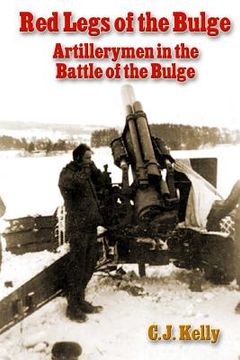Reseña del libro "Red Legs of the Bulge: Artillerymen in the Battle of the Bulge (en Inglés)"
Merriam Press World War 2 History SeriesThe Artillery Branch is one of the most complicated of military science. Like the Engineers, it was a technically demanding field. All of the enlisted complements were highly skilled as well. During the war, recruits felt lucky to be assigned to the artillery. They figured it was safer than the infantry. With the exception of being a forward observer, they were correct. Although making up 16% of an infantry division's strength, it only accounted for 3% of the casualties. the foot soldier thought anyone in the artillery lived a life of relative luxury. That situation changed during the Bulge. It was no longer a safe billet. Battery personnel were some of the first to get hit by enemy shells. The front line came to them as never before. German infantry and tanks bypassed the infantry screen and rolled up on their positions. In an age of indirect fire and advanced observation techniques, direct fire on a target became commonplace. Others, fighting with carbines and bazookas, held off many a thrust by the enemy, some even fighting hand to hand. Desperate men had to call down fire on their own positions to help stave off oncoming Panzers. Recognition has not always come. Other than Napoleon, can the average person name a famous artilleryman? The answer is probably not. Cannoneers, fire direction centers, and artillery observers bracketing fire on targets are usually not fodder for books or movies. Nevertheless, their contributions to the final victory were enormous. Patton, the tanker, often commented that our artillery won the war. The use of artillery reached its zenith in World War II. It accounted for the majority of casualties on the battlefield. The U.S. Army led the way in both gun design and the development of advanced observation techniques taught at places like Fort Sill, Oklahoma. All this innovation came to fruition during the last year of the war with the ability to concentrate firepower on the enemy through the use of combined arms techniques honed in the hedgerows of Normandy. The weather in Northern Europe by December 1944 was atrocious, nullifying the Allies' air superiority. So the artillery had to fill that void. During the first week of the Battle, the U.S. Army was able to amass almost 350 guns of all calibers, one of the largest concentrations in the history of warfare, to defend the Elsenborn Ridge in the northern sector of the Bulge. The Sixth SS Panzer Army literally ran into a wall of steel. Throughout the rest of the campaign, artillery continued to be penultimate battlefield weapon. At Bastogne, standing right alongside the 101st Airborne were Red Legs, many of them African-American. American dominance in field artillery would continue until the end of the war. This work focuses on a small, but very important part of the larger battle in and around St. Vith, highlighting the artillery units from the 106th Infantry Division as well as the 333rd Field Artillery. It tells the story from the artillerymen's point of view. It sheds light on some untold aspects of the war and it will lead to seeking out further information about the conflict and artillery's role in World War II. Contents Chapter 1: Baptism of Fire Chapter 2: The Ring Tightens Chapter 3: The Ring Closes Chapter 4: Parker's Crossroads Chapter 5: Captivity Chapter 6: The Hammelburg Raid Chapter 7: They Fought On Postscript Appendix 1: 106th Division Appendix 2: 106th Artillery Appendix 3: Roster of KIA Bibliography 42 B&W photos 2 illustrations 3 maps

